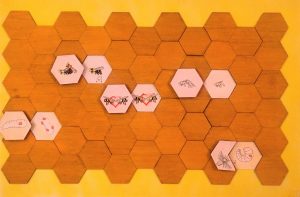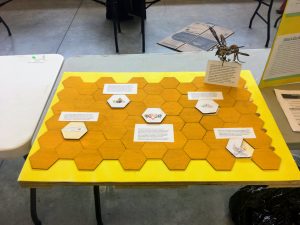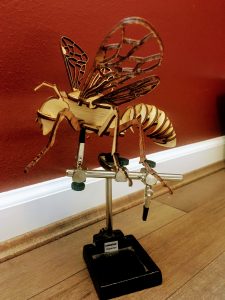4 Colony Collapse Disorder Model
Overview

The 3D model consists of lasercut wood hexagons that resemble honeycomb. They are attached to a foam board, which has sheet metal fastened on the back in order to attach complementary magnets. Each magnet shows a common scene in a honey bee colony that demonstrates Colony Collapse Disorder, known as CCD. The magnets represent the “before” scene, while the images underneath the magnets depict the accompanying “after” scene. This model aims to juxtapose the nascent infiltration of Varroa mites with the damage they cause to the hive.
Model Description

Varroa mites can become trapped within honey bee brood once the pupa caps, which is one of the earliest stages in which honey bees can be infested by varroa. At this stage, the varroa begins to feed off the hemolymph of the honey bee, which weakens the bee’s health.
The varroa mite is known to be an intermediate host of many honey bee pathogens in addition to causing immunosuppression in honey bees. This magnet shows the vertical transmission of parasites and pathogens. As queens mate with more drones during their mating flight, the chances of spreading disease increases. DWV appears with higher frequency and intensity within a colony when that colony also has a varroa infestation.

Horizontal transmission of varroa occurs more frequently than vertical transmission. Only the external body parts, such as the head, thorax and abdomen, are affected. When the varroa mite changes host, it also carries its viral particles with itself, increasing the new host’s vulnerability to pathogens. Varroa commonly enters healthy colonies through intercolonial transmission where an infested bee visits a foreign hive and the mite changes hosts in that new environment.
Honey bees have been found to have a mite-biting grooming tactic in which they can identify varroa on other bees, then bite those mites. Colonies with high grooming rates have lower varroa mite populations. Varroa can die or result in damaged legs after being bitten by a bee.
Honey bees can exhibit varroa sensitive hygiene (VSH) where bees can identify Varroa mites in the hive and remove mites from brood. To do so, the bee uncaps the infested brood, then takes out the mite and drops it, where it falls to the bottom of the hive.

